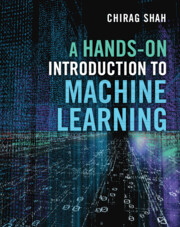Refine search
Actions for selected content:
36762 results in Cambridge Textbooks
7 - Patient information and confidentiality
-
-
- Book:
- Ethics and Law for Australian Nurses
- Published online:
- 25 January 2023
- Print publication:
- 25 January 2023, pp 166-194
-
- Chapter
- Export citation
About the authors
-
- Book:
- Ethics and Law for Australian Nurses
- Published online:
- 25 January 2023
- Print publication:
- 25 January 2023, pp ix-ix
-
- Chapter
- Export citation
Introduction
-
-
- Book:
- Ethics and Law for Australian Nurses
- Published online:
- 25 January 2023
- Print publication:
- 25 January 2023, pp 1-6
-
- Chapter
- Export citation

A Hands-On Introduction to Machine Learning
-
- Published online:
- 20 January 2023
- Print publication:
- 29 December 2022
-
- Textbook
- Export citation

The People's Dictatorship
- A History of Nazi Germany
-
- Published online:
- 20 January 2023
- Print publication:
- 26 January 2023
-
- Textbook
- Export citation
Chapter 1 - A Broad Spectrum Introduction
-
- Book:
- Sustainable Energy
- Published online:
- 17 February 2023
- Print publication:
- 19 January 2023, pp 1-15
-
- Chapter
- Export citation
Chapter 9 - Hydropower
-
- Book:
- Sustainable Energy
- Published online:
- 17 February 2023
- Print publication:
- 19 January 2023, pp 188-212
-
- Chapter
- Export citation
Appendices
-
- Book:
- Sustainable Energy
- Published online:
- 17 February 2023
- Print publication:
- 19 January 2023, pp 400-421
-
- Chapter
- Export citation
Appendix C - Elements
-
- Book:
- Sustainable Energy
- Published online:
- 17 February 2023
- Print publication:
- 19 January 2023, pp 414-418
-
- Chapter
- Export citation
Chapter 4 - Fossil Fuels
-
- Book:
- Sustainable Energy
- Published online:
- 17 February 2023
- Print publication:
- 19 January 2023, pp 63-93
-
- Chapter
- Export citation
Brief Contents
-
- Book:
- Sustainable Energy
- Published online:
- 17 February 2023
- Print publication:
- 19 January 2023, pp v-v
-
- Chapter
- Export citation
Chapter 11 - Solar Energy
-
- Book:
- Sustainable Energy
- Published online:
- 17 February 2023
- Print publication:
- 19 January 2023, pp 251-298
-
- Chapter
- Export citation
Chapter 8 - Geothermal Energy
-
- Book:
- Sustainable Energy
- Published online:
- 17 February 2023
- Print publication:
- 19 January 2023, pp 164-187
-
- Chapter
- Export citation
Appendix A - Energy Conversion Factors
-
- Book:
- Sustainable Energy
- Published online:
- 17 February 2023
- Print publication:
- 19 January 2023, pp 400-401
-
- Chapter
- Export citation
Chapter 14 - Energy Efficiency
-
- Book:
- Sustainable Energy
- Published online:
- 17 February 2023
- Print publication:
- 19 January 2023, pp 355-389
-
- Chapter
- Export citation
Contents
-
- Book:
- Sustainable Energy
- Published online:
- 17 February 2023
- Print publication:
- 19 January 2023, pp vi-xii
-
- Chapter
- Export citation
Chapter 3 - Theoretical Basics
-
- Book:
- Sustainable Energy
- Published online:
- 17 February 2023
- Print publication:
- 19 January 2023, pp 33-62
-
- Chapter
- Export citation
Chapter 5 - Nuclear Energy
-
- Book:
- Sustainable Energy
- Published online:
- 17 February 2023
- Print publication:
- 19 January 2023, pp 94-123
-
- Chapter
- Export citation
Appendix B - Thermodynamic Tables (SI Units)
-
- Book:
- Sustainable Energy
- Published online:
- 17 February 2023
- Print publication:
- 19 January 2023, pp 402-413
-
- Chapter
- Export citation
Chapter 7 - Biomass
-
- Book:
- Sustainable Energy
- Published online:
- 17 February 2023
- Print publication:
- 19 January 2023, pp 141-163
-
- Chapter
- Export citation
